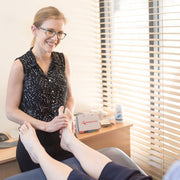- Home
- -
- Foot Health and Happiness
- -
- Are Barefoot Shoes Good For You?
Are Barefoot Shoes Good For You?
August 27, 2020

We sat down with Barefoot Rehabilitation Specialist and Podiatrist Christine McCallum to get the low down on Barefoot technology, and learn why there's a growing wave of people (and podiatrists) going barefoot.

Barefoot Rehabilitation Specialist and Podiatrist Christine McCallum
At its core, the Barefoot approach encourages feet to live their best, natural life. According to Barefoot enthusiasts that means allowing feet to function in the manner for which they were intended- flexible all terrain vehicles with natural muscle movement, wriggling toes, and thousands of happy nerve endings.
Christine, our go-to Barefoot expert, explained that allowing enough room for all five toes to move freely is essential in building strong, healthy feet.
"Our feet are fan-shaped and flexible, with thousands of nerve endings. Allowing toes to move freely is really important. Our big toe must have the space it requires for us to propel forward efficiently, and we need all five of our toes to be engaged to stabilise the foot effectively. This is how they were designed, and how they work best."

The Natural Foot (C) Vivobarefoot
"Brands like Vivobarefoot design shoes that mimic the shape of the natural foot, with a toe box wide enough for all five of our toes, and give feet the potential to operate at their natural best"
So if you find that your toes tend to band together like a school of sardines, completely oblivious to toe-social-distancing-etique, you would do well to free them up, give them a bit of breathing room, and let them do their thing.
Traditionally, Barefootians (we just made that up, and we're running with it) may have roamed free from the constrictions of footwear, and subsequently faced some big decisions come boardroom meetings, rugged terrain, or trips to the shops.
Thankfully, a number of forward thinking footwear brands have come to the party, specialising in a new breed of footwear that allows Barefootians to embrace their naturally footed selves while also being ready (and appropriately shod) to face the world and all it throws at them.

Vivobarefoot Primus Lite Obsidian
Another key feature of Barefoot footewar is flexibility.
"Vivobarefoot uppers and sole units are completely flexible, allowing the musculoskeletal system of the foot do the job it’s intended to do. The foot has 33 joints and the very purpose of a joint is to move. Ligaments control this movement while muscles and tendons create this movement.We need our muscles to be strong to allow healthy movement and not put undue stress and strain on out joints and ligaments. Recent MRI studies have shown that a painful, injured foot has smaller, weaker muscles." says Christine

Vivobarefoot Primus Trail FG Obsidian
Barefoot shoes have a thinner sole than a traditional shoe to allow you to feel the surface you walk on. The vibrations that are created when we walk send messages to the proprioceptive nerves of the feet, which tells our brain where our joints are positioned. Without this feedback, our feet struggle to move effectively and this can result in fatigue and overuse.
"If this sounds like your feet but you still need a little bit of assistance maintaining arch control, you can fit a small orthotic device inside the Vivobarefoot shoe. All feet are unique, and the features you require in footwear may also differ."
Christine also reminds us that if you have not worn a minimalist shoe before, you need to ‘ween’ yourself off gradually from a traditional shoe and be sure to start exercising and strengthening your feet.

